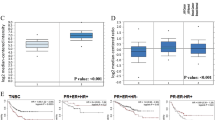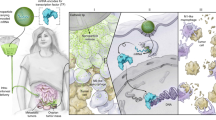Abstract
Macrophage migration inhibitory factor (MIF) has been identified as a major gene product upregulated in breast cancer cells–tissues upon the accumulation of macrophages. However, regulatory role of MIF in tumor microenvironment is not well understood. Previously, we have developed small interfering RNA (siRNA)-loaded nanoparticle system to effectively reduce MIF expression in both breast cancer cells and macrophages. Using this nanoparticle system, in this study we demonstrated that the siRNA-induced MIF reduction in murine mammary cancer line 4T1 and human breast cancer line MDA-MB-231 resulted in significant reduction of cell proliferation and increase of apoptosis; the siRNA-induced MIF reduction in tumor-associated macrophages resulted in a significant reduction of surface expression of CD74 and CD206 and a significant increase of surface expression of major histocompatibility complex II, as well as intracellular expression of tumor necrosis factor-α and interleukin-2. A direct injection of the MIF-siRNA-loaded nanoparticles into 4T1 tumor in mice resulted in effective reduction of intratumoral MIF. This led to a reduction of tumor growth and metastasis. This also resulted in a reduction of circulating myeloid-derived suppressive cells both in number and in suppressive function. CD4 T-cell infiltration to tumor was increased. More importantly, this not only slowed the growth of treated 4T1 tumor, but also delayed the growth and metastasis of a contralateral untreated 4T1-luc tumor, suggesting the development of systemic antitumor responses. This study demonstrates for the first time that the siRNA-mediated intratumoral MIF reduction can induce antitumoral immune response via reducing systemic immune suppression.
This is a preview of subscription content, access via your institution
Access options
Subscribe to this journal
Receive 12 print issues and online access
$259.00 per year
only $21.58 per issue
Buy this article
- Purchase on Springer Link
- Instant access to full article PDF
Prices may be subject to local taxes which are calculated during checkout







Similar content being viewed by others
References
Zardavas D, Baselga J, Piccart M . Emerging targeted agents in metastatic breast cancer. Nat Rev Clin Oncol 2013; 10: 191–210.
Mao Y, Keller ET, Garfield DH, Shen K, Wang J . Stromal cells in tumor microenvironment and breast cancer. Cancer Metastasis Rev 2013; 32: 303–315.
Siveen KS, Kuttan G . Role of macrophages in tumour progression. Immunol Lett 2009; 123: 97–105.
Coffelt SB, Hughes R, Lewis CE . Tumor-associated macrophages: effectors of angiogenesis and tumor progression. Biochimica Biophysica Acta 2009; 1796: 11–21.
Mantovani A, Schioppa T, Porta C, Allavena P, Sica A . Role of tumor-associated macrophages in tumor progression and invasion. Cancer Metastasis Rev 2006; 25: 315–323.
Pollard JW . Macrophages define the invasive microenvironment in breast cancer. J Leukocyte Biol 2008; 84: 623–629.
Nishihira J, Ishibashi T, Fukushima T, Sun B, Sato Y, Todo S . Macrophage migration inhibitory factor (MIF): its potential role in tumor growth and tumor-associated angiogenesis. Ann N Y Acad Sci 2003; 995: 171–178.
Leth-Larsen R, Lund R, Hansen HV, Laenkholm AV, Tarin D, Jensen ON et al. Metastasis-related plasma membrane proteins of human breast cancer cells identified by comparative quantitative mass spectrometry. Mol Cell Proteomics 2009; 8: 1436–1444.
Bifulco C, McDaniel K, Leng L, Bucala R . Tumor growth promoting properties of macrophage migration inhibitory factor. Curr Pharm Des 2008; 14: 3790–3801.
Jung H, Seong H, Ha H . Critical role of cysteine residue 81 of macrophage migration inhibitory factor (MIF) in MIF-induced inhibition of p53 activity. J Biol Chem 2008; 283: 20383–20396.
Bach JP, Rinn B, Meyer B, Dodel R, Bacher M . Role of MIF in inflammation and tumorigenesis. Oncology 2008; 75: 127–133.
Nishihira J, Ishibashi T, Fukushima T, Sun B, Sato Y, Todo S . Macrophage migration inhibitory factor (MIF): its potential role in tumor growth and tumor-associated angiogenesis. Ann N Y Acad Sci 2003; 995: 171–182.
Schober A, Bernhagen J, Weber C . Chemokine-like functions of MIF in atherosclerosis. J Mol Med 2008; 86: 761–769.
Verjins E, Noetzel E, Bektal N, Schutz A, Lue H, Lennartz B et al. Dual role of macrophage migration inhibitory factor (MIF) in human breast cancer. BMC Cancer 2009; 9: 230–238.
Whalley K . Breakthrough for systemic RNAi. Nat Rev Genet 2006; 7: 331–338.
Zhang M, Gao Y, Zhao B, Kim J . Development of glucan-based siRNA carrier system transfecting primary macrophages. Plos One 2015; 10: 118472–118488.
Kleemann R, Hausser A, Geiger G, Mischke R, Burger-Kentischer A, Flieger O et al. Intracellular action of the cytokine MIF to modulate AP-1 activity and the cell cycle through Jab1. Nature 2000; 408: 211–224.
Mitchell RA, Liao H, Chesney J, Fingerle-Rowson G, Baugh J, David J et al. Macrophage migration inhibitory factor (MIF) sustains macrophage proinflammatory function by inhibiting p53: regulatory role in the innate immune response. Proc Natl Acad Sci USA 2002; 99: 345–349.
Miretti S, Roato I, Taulli R, Ponzetto C, Cilli M, Olivero M et al. A mouse model of pulmonary metastasis from spontaneous osteosarcoma monitored in vivo by luciferase imaging. Plos One 2008; 3: 1828–1835.
Rabinovich GA, Gabrilovich D, Sotomayor EM . Immunosuppressive strategies that are mediated by tumor cells. Annu Rev Immunol 2007; 25: 267–296.
Allavena P, Sica A, Garlanda C, Mantovani A . The Yin-Yang of tumor-associated macrophages in neoplastic progression and immune surveillance. Immunol Rev 2008; 222: 155–167.
Leng L, Metz CN, Fang Y, Xu J, Donnelly S, Baugh J et al. Signal transduction initiated by binding to CD74. J Exp Med 2003; 197: 1467–1478.
Beswick EJ, Reyes VE . CD74 in antigen presentation, inflammation, and cancers of the gastrointestinal tract. World J Gastroenterol 2009; 15: 2855–2864.
Starlets D, Gore Y, Binsky I, Haran M, Harpaz N, Shvidel L et al. Cell-surface CD7 4 initiates a signaling cascade leading to cell proliferation and survival. Blood 2006; 107: 4807–4816.
Morand EF, Leech M, Bernhagen J . MIF: a new cytokine link between rheumatoid arthritis and atherosclerosis. Nat Rev Drug Discov 2006; 5: 399–412.
Stosic-Grujicic S, Stojanovic I, Nicoletti F . MIF in autoimmunity and novel therapeutic approaches. Autoimmun Rev 2009; 8: 244–256.
AbD online technology note. Minireview: macrophage polarization introduction. Available at http://www.abdserotec.com/macrophage-polarization-minireview.html.
Hansson GK, Libby P, Schonbeck U, Yan Z . Innate and adaptive immunity in the pathogenesis of atherosclerosis. Circulation Res 2002; 91: 281–291.
Underhill DM, Bassetti M, Rudensky A, Aderem A . Dynamic interaction of macrophages with T cells during antigen presentation. J Exp Med 1999; 190: 1909–1914.
Oppenherim J . IL-2: more than a T cell growth factor. J Immunol 2007; 179: 1413–1414.
Girard E, Strathdee C, Trueblood E, Queva C . Macrophage migration xinhibitory factor produced by the tumor stroma but not by tumor cells regulates angiogenesis in the B16-F10 melanoma model. Br J Cancer 2012; 107: 1498–1505.
Talmadge J, Gabrilovich D . History of myeloid derived suppressor cells. Nat Rev Cancer 2013; 13: 739–752.
Wesolowski R, Markowitz J, Carson W . Myeloid derived suppressor cells—a new therapeutic target in the treatment of cancer. J Immunother Cancer 2013; 1: 10–21.
Cole S, Montero A, Garret-Mayer E, Onicescu G, Vandenberg T, Hutchens S et al. Elevated circulating myeloid derived suppressor cells (MDSC) are associated with inferior overall survival (OS) and correlated with circulating tumor cells (CTC) in patients with metastatic breast caner. Cancer Res 2009; 69: 4135–4144.
Acknowledgements
We thank Case Comprehensive Cancer Center-Flow Core Lab for the kind assistance and support on FACS analysis. We thank Small Animal Imaging Center of Case Western Reserve University for the kind assistance and support on imaging analysis. We also thank Professor Bingcheng Wang at School of Medicine of Case Western Reserve University for kindly providing various murine and human breast tumor lines for this study. This study was supported by CTSC (Clinical Translational Scientific Collaboration) grant of Coulter CON501510-69361 (MZ) and by Immunogene Therapy Fund from Seidman Cancer Center (JAK).
Author information
Authors and Affiliations
Corresponding authors
Ethics declarations
Competing interests
The authors declare no conflict of interest.
Additional information
Supplementary Information accompanies the paper on Cancer Gene Therapy website
Supplementary information
Rights and permissions
About this article
Cite this article
Zhang, M., Yan, L. & Kim, J. Modulating mammary tumor growth, metastasis and immunosuppression by siRNA-induced MIF reduction in tumor microenvironment. Cancer Gene Ther 22, 463–474 (2015). https://doi.org/10.1038/cgt.2015.42
Received:
Revised:
Accepted:
Published:
Issue Date:
DOI: https://doi.org/10.1038/cgt.2015.42
This article is cited by
-
Nanotherapeutic approaches targeting angiogenesis and immune dysfunction in tumor microenvironment
Science China Life Sciences (2018)
-
Tumor-associated macrophages: unwitting accomplices in breast cancer malignancy
npj Breast Cancer (2016)



